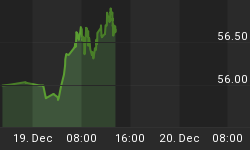In October 2004, while rummaging and ruminating in our library of secular (very-long-term) charts, we found something so fascinating that it compelled us to make our very first stock market forecast[1]. We called it "Quo Vadis" - where are we going? Here, we'd like to share that finding with you.
Our forecast calls for the S&P 500 to fall to 450 in October 2006 - a plunge of some 62% from current levels. It is a dire forecast that breaks the cardinal rule of forecasting: give a price or a date, never both! But, since this is our first, and probably last, such venture, why not go for it?
Point 1 - Trendlines
The chart below shows two key elements of the secular trend: 1) the well-defined trendlines that have provided resistance and support at key times, and 2) the blow-offs in the late 20's and the late 90's.

The chart shows the blow-offs to be the anomalies, not the norm. For that reason, we believe the index will fall back into the channel, and someday test the lower support line. It's plausible, and debatable.
The 1920's blow-off presaged the worst stock market crash in U.S. history. The bursting of the dot-com bubble of the late 90's ravaged the tech sector, but did not cause such a broad stock market rout. As the log scale shows, the two blow-offs were identical percentage moves, which we find interesting.
Our conclusion: We expect the lower (support) trendline to be tested "someday," but when?
Point 2 - The Four-year Cycle
The four-year stock market cycle is well known to market historians because of its impressive record of marking important lows, nominally in October, every four years. The following chart marks the October low in each cycle from 1966 to 2018.

"Optimistically," we could be facing many years of little or no gain if the trendline test comes in, say, 2018. Pessimistically, we could have a crash if it comes at the next cycle low, in 2006. Talk about a rock and a hard place!
Our conclusion: We believe the secular support trendline will be tested at a four-year cycle low, but which one? Aiding us in our quest for that answer is a very old friend of market technicians, Leonardo of Pisa - a.k.a. Fibonacci.
Point 3 - Corrections
The next chart overlays the late, great, secular bull market of 1974-2000 with a Fibonacci "golden mean" correction to 0.618, projecting a price of 450!

Many technicians consider the 0.618 level to be the first potentially important support in a correction, and it often marks important lows. This best-case Fibonacci correction would be dire, indeed, but it would "only" correct Alan Greenspan's period of "irrational exuberance."
Our conclusion: The 450 price point will likely be seen again.
The Case for Quo Vadis
Our case consists of the fascinating convergence of those three points, as shown in the composite chart that follows.

Fascinating, it may be, but maybe it will come to pass, and maybe it won't. It is arguable.
Our conclusion: Personally, we found it rather compelling - thus our forecast. However, it lacks something - a cause, a catalyst. What could possibly cause such a crash?
The Catalyst
We limited our "catalytic cogitations" to the financial/economic realm, because acts of God, and "human devils," are beyond the range of our crystal ball, but those are possibilities. Our answer is summarized as "a chain-reaction to a big bang elsewhere in financial markets that sends the stock market plunging."
Where might that "big bang" occur? In the derivatives markets: that $200 Trillion, unfathomable, unregulated, underworld of incestuous deals with the Devil!
The trouble might start with interest rate swaps, or foreign exchange (forex) rates, or in some other area. But wherever it starts, one or more counterparties will default on their obligations, causing other counterparty defaults, including firms who can't pay-off on their losers because they can't collect on their winners. The resulting cascade of counterparty bankruptcies will spread defaults across all classes of derivatives, causing financial markets to seize-up (at least briefly), engulfing the stock market in the chaos that started elsewhere. And, as unbelievable as this may sound, the stock market's carnage could be the least of it!
Think it can't happen? Think back to 1998 when, virtually overnight, the relatively-small, but heavily-leveraged, derivatives-trading hedge fund, Long-term Capital Management (LTCM) brought the world to the brink of financial Armageddon.
Now, think of today's far-larger derivatives markets that are still just as unregulated and opaque, adding in for good measure a thousand, mostly offshore and unregulated, derivatives-trading hedge funds. Now, think of the housing/mortgage-finance bubble that is leaking air, with its Trillions of dollars in mortgage-backed securities, and Fannie Mae with no-one-knows-what on its derivatives books. Now, think of Refco as the canary in the coal mine. Now, think - Quo Vadis?
Note:
1. http://www.yourmutualfunds.com/, October 2004 Chart of the Month, "Quo Vadis"















